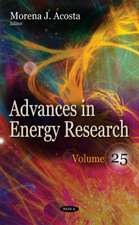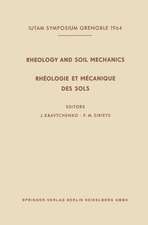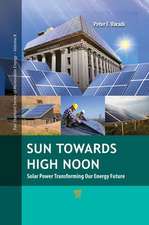Global Environmental Biotechnology: Proceedings of the Third International Symposium on the International Society for Environmental Biotechnology
Editat de D.L. Wiseen Limba Engleză Hardback – 30 noi 1997
This text includes papers from the third biennial meeting of the International Society for Environmental Biotechnology, the ISEB, held in Boston, Massachusetts, on the campus of Northeastern University. Technical oral presentations of state-of-the-art research were integrated with tutorials and workshops by practising technologists in the broad field of environmental biotechnology. This meeting was in every respect truly global. For example, presentations were heard from technical workers in Southeast Asia, Russia, China, Europe, North Africa, India, and the United States. By having these selected presenters, all participants benefited from this interactive symposium. Various persons of political stature were the keynote, banquet, and luncheon speakers; these social events further promoted informal exchange of ideas, discussions of technical problems, and exploration of new applications. This international symposium on environmental biotechnology was held on the campus of Northeastern University, but all Boston area universities were included and participated as conference Co-Chairs.
This symposium was considered a success because workers with experience in one area of environmental biotechnology learned from the wealth of established backgrounds of those in other areas of environmental biotechnology. To formally disseminate conference results, all technical presentations were reviewed for formal publication.
| Toate formatele și edițiile | Preț | Express |
|---|---|---|
| Paperback (1) | 1831.60 lei 6-8 săpt. | |
| SPRINGER NETHERLANDS – dec 2010 | 1831.60 lei 6-8 săpt. | |
| Hardback (1) | 1838.51 lei 6-8 săpt. | |
| SPRINGER NETHERLANDS – 30 noi 1997 | 1838.51 lei 6-8 săpt. |
Preț: 1838.51 lei
Preț vechi: 2242.09 lei
-18% Nou
Puncte Express: 2758
Preț estimativ în valută:
351.85€ • 365.97$ • 290.47£
351.85€ • 365.97$ • 290.47£
Carte tipărită la comandă
Livrare economică 14-28 aprilie
Preluare comenzi: 021 569.72.76
Specificații
ISBN-13: 9780792345152
ISBN-10: 0792345150
Pagini: 610
Ilustrații: XVIII, 610 p.
Dimensiuni: 156 x 234 x 35 mm
Greutate: 1.07 kg
Ediția:1997
Editura: SPRINGER NETHERLANDS
Colecția Springer
Locul publicării:Dordrecht, Netherlands
ISBN-10: 0792345150
Pagini: 610
Ilustrații: XVIII, 610 p.
Dimensiuni: 156 x 234 x 35 mm
Greutate: 1.07 kg
Ediția:1997
Editura: SPRINGER NETHERLANDS
Colecția Springer
Locul publicării:Dordrecht, Netherlands
Public țintă
ResearchCuprins
Metals: mine drainage, removal, toxicity.- Metal bioaccumulation by Pseudomonas: a way to bioremediation.- Detection of heavy metal ion resistance genes in lead-resistant bacteria.- Stress responses of three Pseudomonas species and Stenotrophomonas maltophilia to heat and selected pollutants.- Use of a luminescent bacterial biosensor for biomonitoring and characterisation of arsenic toxicity of chromated copper arsenate (CCA).- Genetic engineering and its potential for mercury(II) bioremediation.- Siderophore alcaligin E production by Alcaligenes eutrophus CH34: features of the ale-operon and application perspectives of alcaligin E for leaching of heavy metals.- Bacterial sulfate reduction treatment of mining-related wastewaters: pilot plant results.- Study of cadmium uptake and accumulation in Lactobacillus plantarum and Escherichia coli.- Biosorption and desorption studies of chromium(III) by free and immobilised rhizobium (BJVr 12) cells.- The interactive effect of environmental carcinogens namely Cd and Ni on rat DNA.- Adsorption and uptake of nickel by Chlamydomonas acidophilus.- A molecular approach to understanding aluminum tolerance in soybean (Glycine max L.).- Biosorption of heavy metals by Aspergillus niger.- Biosorption of copper by living Phanerochaete chrysosporium mycelium.- Waste treatment/monitoring.- Codigestion of olive oil mill wastewaters together with manure, household waste or sewage sludge.- Controlled release of herbicides from biodegradable matrices.- Accelerated coffee pulp composting.- Fungal biomass estimation in batch solid substrate cultivation using asymptotic observation.- Multivariable model predictive control of a solid substrate pilot bioreactor: A simulation study.- An aseptic pilot bioreactor for solid substrate cultivation processes.- Treatment of wastewater from a multi-product food processing company, in upflow anaerobic sludge blanket (UASB) reactors: The effect of seasonal variation.- Analysis of immobilised cell bioreactors for desulfurisation of flue gases and sulfite/sulfate laden wastewater.- Sensor technology applied to the environment.- The effects of increasing the concentration and distribution of a synthetic wastewater to a modified bench scale rotating biological contactor.- Solid substrate fermentation of agroresidues for value added products: the Malaysian experience.- Treatment of oily soil with microbes in the laboratory.- The treatment of cumene hydroperoxide containing wastewaters.- Bioremediation: In situ/Rectors/Basic Studies.- Risk assessment at a JP-4 contamination site after active remediation.- Detection of bacterial DNA sequences via oligonucleotidebased biosensors.- Expectations for commercial adoption of new heavy metal bioremediation technologies.- Preliminary respirometer studies for the bioremediation of PAH contaminated soils.- Innovative bioremediation technologies: The DOD/AATDF contribution.- Bench scale investigations of the effects of biosurfactants on the bioavailability of hydrocarbon contaminants.- Accumulation of catechol by a wild-type strain of Rhodococcus from benzene.- Anaerobic degradation and production of alkane/alkene by a new facultative chemoautotrophic bacterium strain HD-1.- Biodegradation.- Gas-phase methyl ethyl ketone biodegradation in a tubular biofilm reactor: microbiological and bioreactor aspects.- and PCR detection of Desulfomonile tiedjei in soil slurry microcosms.- Enhancement of the biodegradability of wastewater containing recalcitrant or inhibitory chemical compounds by photocatalytic pre-oxidation.- Anaerobic bioremediation of explosives-contaminated soil: a laboratory study.- Evaluation of high molecular weight PAH degradation by a pyrene-enriched microbial community in inoculated soils.- Application of bioreactors for bioremediation.- Biodegradation pathway of atrazine in soil of northern Israel.- Kinetics and population dynamics during biodegradation of phenol by a binary mixed culture.- ‘Soft’ remediation strategies: examples for activation of microbiological self-cleaning potencies in contaminated water, sediment and soil.- Rapid detection of the phenol-carboxylating strain 6, an anaerobic gram-positive bacterium, in soil by PCR.- The application of nitrate as an alternative electron acceptor for the remediation of contaminated sites.- Biofortified farming systems for sustainable agriculture and improved environment.- Rapid bioassessment of intermittent streams in the Upper Brazos River watershed.- Potentialities of nitrophenols-degrading microorganisms.- Comparative competitiveness of strains degrading xenobiotics and microorganisms from various ecosystems.- Isolation and characterisation of a new lipopeptide biosurfactant produced by Arthrobacter sp. MIS38.- Respirometric protocol to evaluate acute microbial inhibition in activated sludge.












